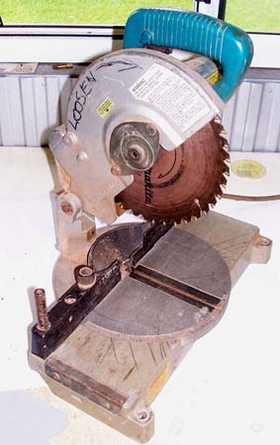 |
|||||
Miter Saw,Timber Drop Saw
Drop saw, mitre saw, compound miter saws all use the more or less universal TCT saw blades. Depending on the materials being cut, they can be quite coarse, not so many teeth, or quite fine toothed and so dearer. The more teeth, the dearer they are to sharpen too. Set your mitre saw up on some sort of a bench, (planks on trestles etc.) that is straight and long enough to support the timber. Working off the floor sucks. Take a bit of time to set up a bench and the time you spent will be well repaid in the comfort and accuracy of working at the correct height. Of course there are now purpose made saw benches, or saw stands out there, complete with extended fences and adjustable stops . The only time I work on the floor with a drop saw, metal or timber is when the material is heavy. It is easier then to move the saw to the material. They are great for repetition work. Got 20 sets of architraves to cut and fix? Fix your saw down firm, set up stops on your bench and cut 'em all in one whack. The one in the shot here is a small 210mm. It has an electric brake that slows the blade real quick when you cut the switch. I have a larger 355mm but it's a ball breaker carrying anywhere. I hardly ever use it. The gap in the main fence of a standard miter saw ( mitre saw ) is quite wide to allow the blade to swing to different angles. To stop small offcuts jamming in the gap there are usually small sliders at the back of the fence that allow the gap to be closed. Adjust them each time you move the angle of cut to close the gap.My larger miter saw does not have any sliders. If I have a lot of cuts to do at the same angle, I always screw on a piece of straight softwood to the fence, making a new face to the main fence. Then the first cut through it gives me the minimum gap, so that even small offcuts are supported. As soon as it wears into a larger gap, I make another. These saws are also commonly used to cut aluminium. An aluminium miter saw is set up differently from the timber set up. The blades are a lot finer toothed than timber ones, commonly around 100 teeth. The cutting angle has less rake also. Don't use a timber blade for cutting aluminium. Get a proper blade and make sure the fence is in good condition. Razor sharp offcuts flying about is something you don't need. That being said, you can do the odd cut in aluminium with a timber saw blade that is in good condition, if you take precautions and are well aware of the dangers. The miter saw should be fixed down firmly and the work should be also clamped down. I would only do it if the off cut is of a reasonable size and controllable. If you have a lot of aluminium to cut, buy a proper blade. Don't start the saw with the blade touching the work. It is easy to do, just after you have lowered the blade to check for being in line with your pencil mark. Keep the timber tight against the fence and also tight to the base. If you have a bend in the timber read the circular saw section on kickback, the same things apply I have never had a job that justified buying a sliding compound miter saw, I always make up a timber miter box for the odd job, and use a sharp panel saw. ( I must admit they are a fantastic tool though, and getting cheaper too ). They give you the option of cutting compound angles, of course, but their real strength is in being able to do it on wider boards accurately. Some models even have a laser sight to show you the exact position of the cut to be made. Not found it yet? Try this FAST SITE SEARCH or the whole web |
Hire Equipment  Furniture Fittings - Architectural Hardware - Electronic Locking Systems - Technical Hardware BuilderBill sponsorship Power tool related pages
|
||||
|
|
|||||
|
Please Note! The information on this site is offered as a guide only! When we are talking about areas where building regulations or safety regulations could exist,the information here could be wrong for your area. It could be out of date! Regulations breed faster than rabbits! You must check your own local conditions. Copyright © Bill Bradley 2007-2012. All rights reserved. |
|||||
